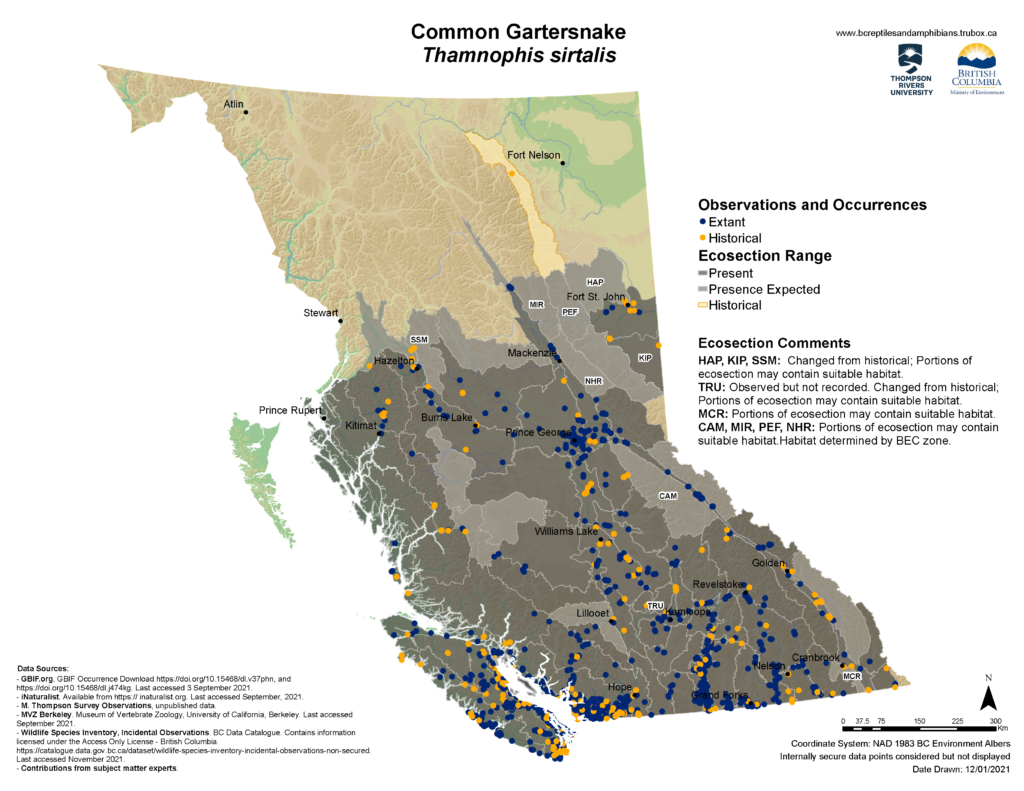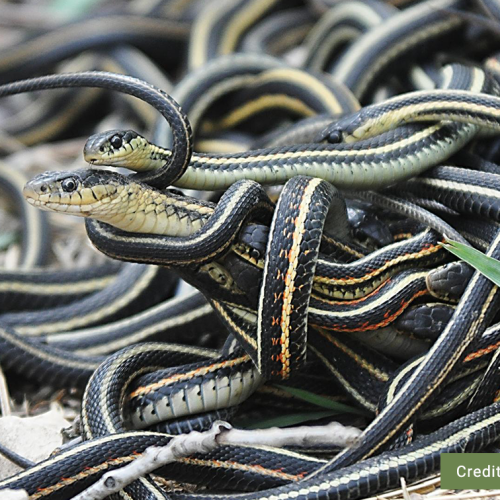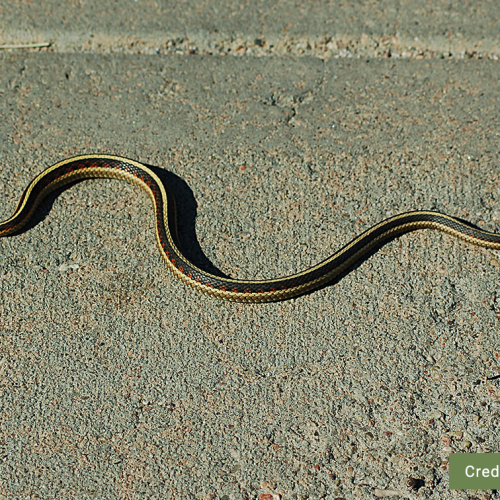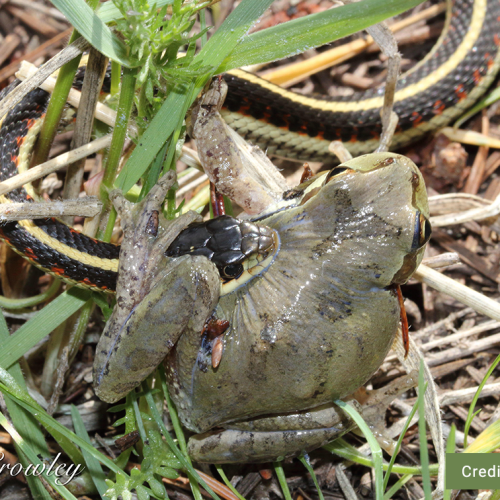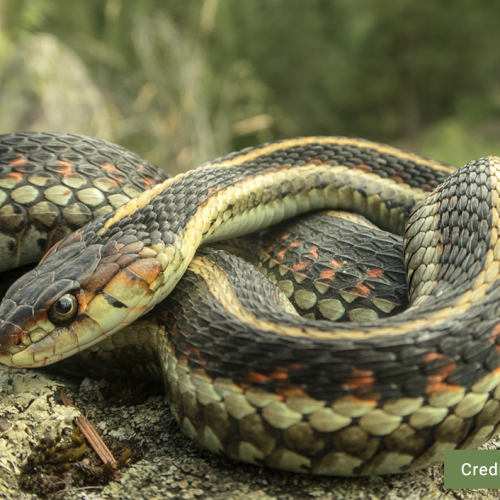Credit: Laura Matthias
Common Gartersnake
Thamnophis sirtalis
Description
Other names: Rana aurora aurora
The Common Gartersnake is a medium-sized, diurnalDefinition:Active during the day. snake that will grow to a mature size from 46 – 130 cm; snakes that occupy more northerly habitats tend to grow larger than snakes in the south. Males are typically a fair amount smaller than females, as female fecundityDefinition:Tooltip content increases with body size.
They have a large head with 7 yellow upper labialDefinition:Referring to the lips, such as a marking along the lip. scales and distinct eyes that have large, round pupils. The body is long and slender and is black or gray-green with a bright yellow-green dorsal stripe and red barring along the sides with lateral stripes just below. The scales on the dorsal body are strongly keeledDefinition:Scales that contain a ridge down the centre that may or may not extend to the tip of the scale.. The belly is typically pale yellow but may also be dark or black, with the chin and neck having the lightest colour.
When preparing for ecdysisDefinition:The process of shedding the dead outer skin in reptiles. the colouration will become dull, and the eyes will glaze over blue-gray. Juvenile Common Gartersnakes have the same colouration and markings as adults, although they are typically brighter and around 20 cm at birth.
Listen to the Indigenous words for “snake” here!
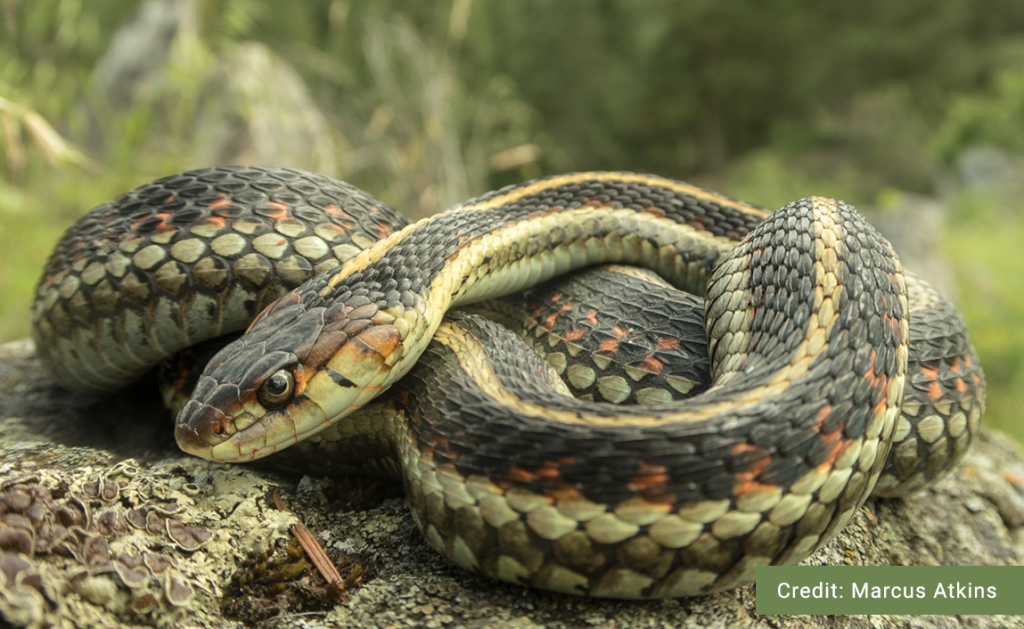
Similar Species
The Common Gartersnake may be easily confused with the other species of Garter Snake in British Columbia; the Western Terrestrial Gartersnake and the Northwestern Gartersnake. Common and Northwestern Gartersnakes will typically only have 7 scales on the upper lip, whereas Western Terrestrial Gartersnakes will typically have 8, with one of them being enlarged. The western sub-species of Common Gartersnake that occurs in British Columbia usually has red bars on the sides between the dorsal and lateral stripes. Overall, Western Terrestrial and Northwestern Gartersnakes are generally lighter in colour and tend to lack red bars on the sides.
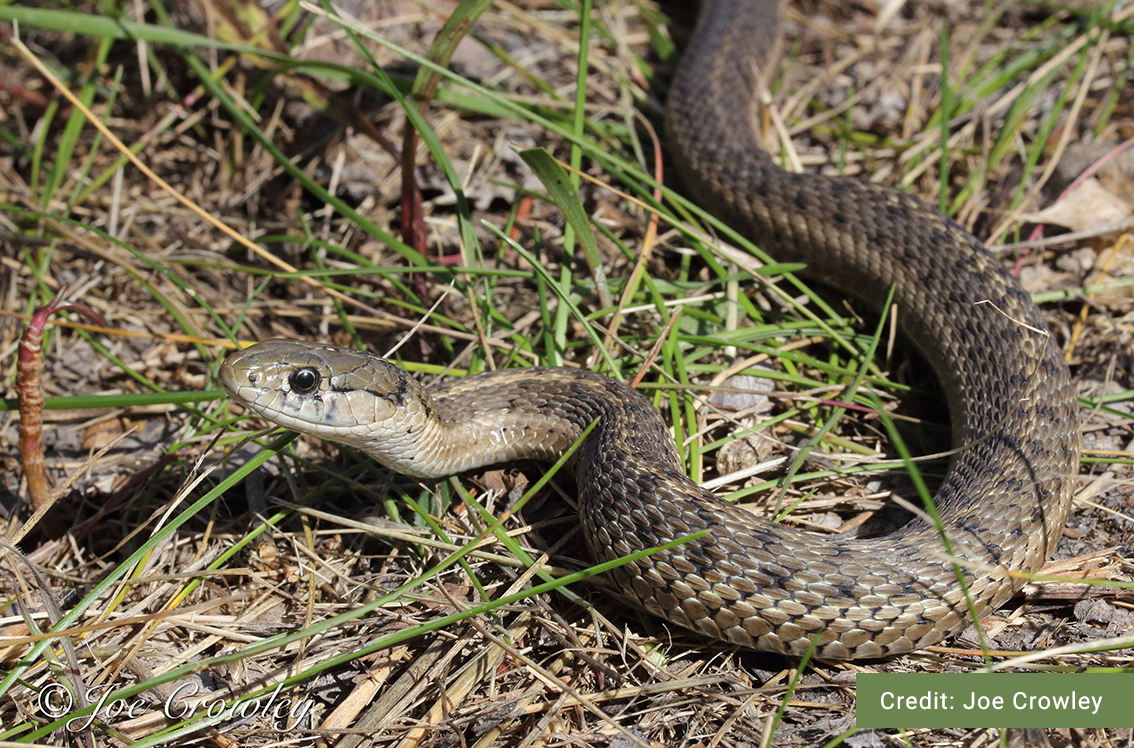
Western Terrestrial Gartersnake
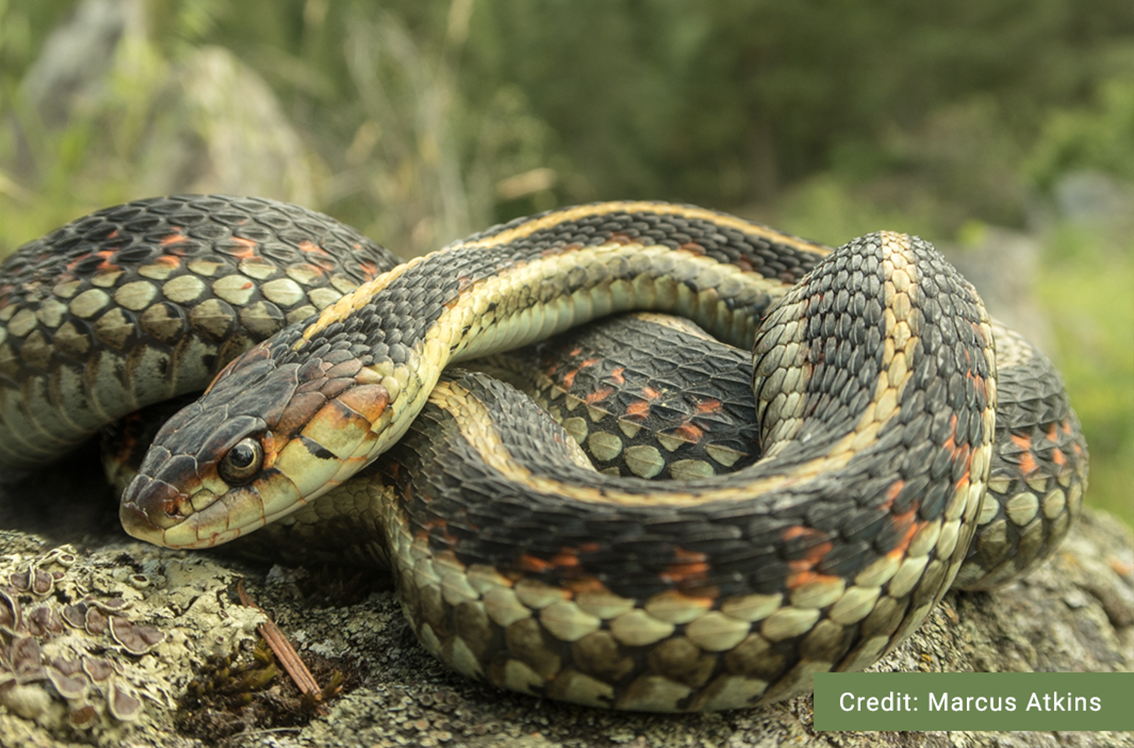
Common Gartersnake
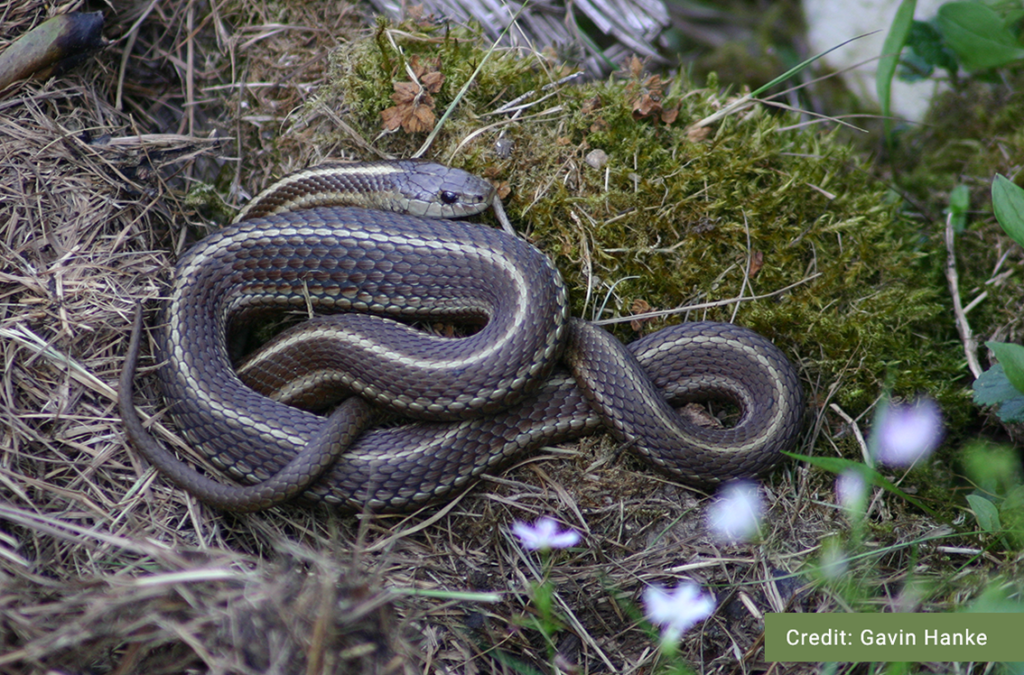
Northwestern Gartersnake
Distribution
There are three recognized subspecies of the Common Gartersnake in British Columbia.
The Puget Sound Gartersnake (Thamnophis sirtalis pickeringi) – found on Vancouver Island and throughout the Lower Mainland.
The Valley Gartersnake (Thamnophis sirtalis fitchi) – found across southern B.C. and the northern coast to Yukon.
The Red-sided Gartersnake (Thamnophis sirtalis parietalis) – found in Eastern B.C. along the Rockies and extends east towards the prairies
Habitat
On Vancouver Island where the winter conditions are relatively mild, Common Gartersnakes may hibernate alone or in smaller groups, as there is more available denning habitat due to the warmer temperatures and lack of snow. Common Gartersnakes emerge from hibernacula in the spring and are generally active from March through to November, depending on the region.
Common Gartersnakes are successful in a broad array of habitats including grasslands, forests, subalpine, and urban areas, but in all of these habitats they are most commonly associated with aquatic environments like wetlands, ponds, marshes, river valleys, or urban waterways. In all of these habitats, cover is an important microhabitat feature for providing shelter from direct sunlight and predators.
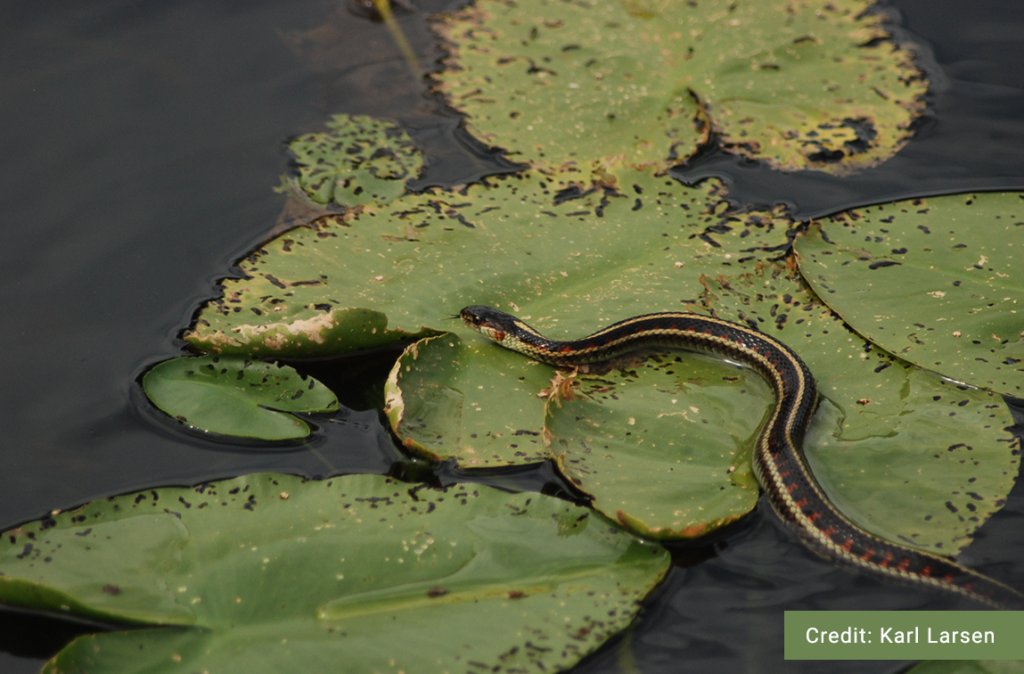
Reproduction
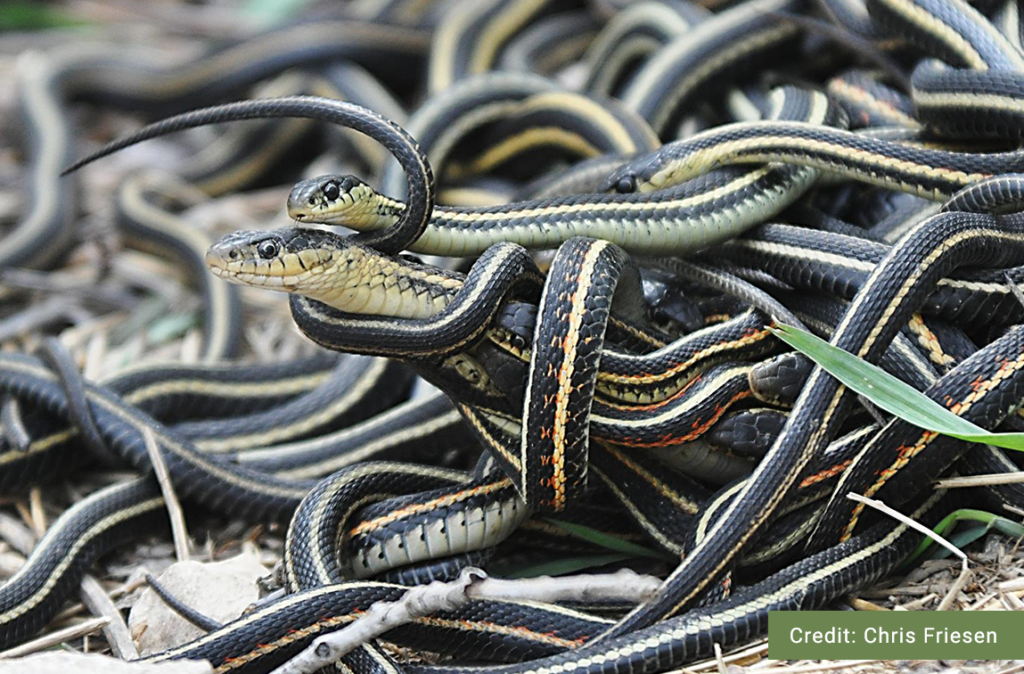
Diet
Common Gartersnakes are able to handle and eat prey that are too toxic and unpalatable for other predators. They can eat toxic Rough-skinned Newts and poisonous Western Toads without major adverse effects. However, prey with particularly potent toxins appear to send Common Gartersnakes into a ‘daze’ that makes them so sluggish that they may appear drunk.
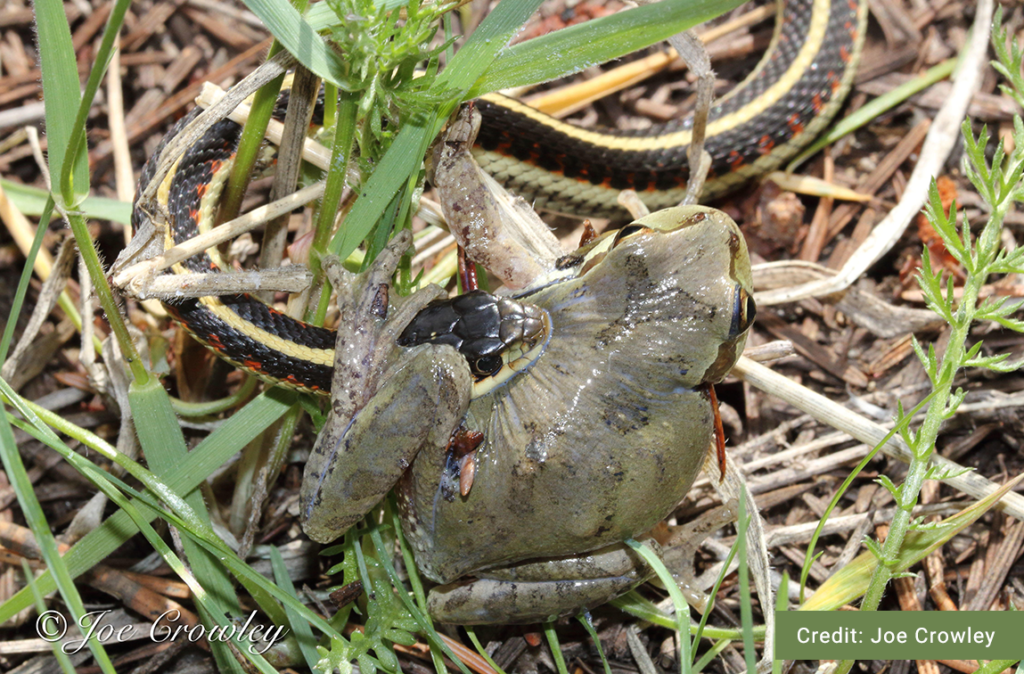
Conservation Status
Global: G5 (2016)
Provincial: S5 (2018)
BC List: Yellow
Learn more about conservation status rankings here
Threats

Did You Know?
Fact #1
Fact #2
Fact #3
Species Account Author: Marcus Atkins
B.C. Conservation Data Centre. 2010. Species Summary: Thamnophis sirtalis. B.C. Minist. of Environment. Available: https://a100.gov.bc.ca/pub/eswp/ (accessed Jun 14, 2021).
B.C. Conservation Data Centre. 2011. Conservation Status Report: Thamnophis sirtalis. B.C. Minist. of Environment. Available: https://a100.gov.bc.ca/pub/eswp/ (accessed Jun 14, 2021).
B.C. Conservation Data Centre. 2021. BC Species and Ecosystems Explorer. B.C. Minist. of Environ. Victoria, B.C. Available: https://a100.gov.bc.ca/pub/eswp/ (accessed Jun 14, 2021).
Gregory, P.T. 1978. Feeding habits and diet overlap of three species of garter snakes (Thamnophis) on Vancouver Island. Canadian Journal of Zoology 56:1967-1974.
Gregory, P.T. 1984. Habitat, diet, and composition of assemblages of garter snakes (Thamnophis) at eight sites on Vancouver Island. Canadian Journal of Zoology 62:2013-2022.
Gregory, P.T. 2006. Influence of income and capital on a viviparous snake: direct and indirect effects. Journal of Zoology 270:414-419.
Gregory, P.T. 2007. Biology and conservation of a cold-climate snake fauna. In C. Seburn and C. Bishop, editors. Ecology, Conservation and Status of Reptiles in Canada. SSAR, Herpetological Conservation 2.
Gregory, P.T., and K.J. Nelson. 1991. Predation on fish and intersite variation in the diet of Common Garter Snakes, Thamnophis sirtalis, on Vancouver Island. Canadian Journal of Zoology 69:988-994.
Gregory, P.T., and K.W. Larsen. 1993. Geographic variation in reproductive characteristics among Canadian populations of the common garter snake (Thamnophis sirtalis). Copeia 1993:946-958.
Larsen, K.W. 1986. Ecology of the Common Garter Snake, Thamnophis sirtalis, at the northern limit of its range. MSc Thesis. University of Victoria, Victoria. Larsen, K.W. 1987. Movements and behavior of migratory garter snakes, Thamnophis sirtalis. Canadian Journal of Zoology 65:2241-2247.
Larsen, K.W., and P.T. Gregory. 1989. Population size and survivorship of the Common Garter Snake, Thamnophis sirtalis, near the northern limit of its distribution. Holarctic Ecology 12:81-86.
https://www.bcreptiles.ca/snakes/comGarter.htm
http://linnet.geog.ubc.ca/efauna/Atlas/Atlas.aspx?sciname=Thamnophis%20sirtalis
http://canadianherpetology.ca/species/species_page.html?cname=Valley%20Gartersnake

